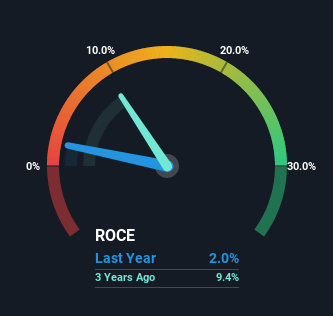DHI Group (NYSE:DHX) May Have Issues Allocating Its Capital
When researching a stock for investment, what can tell us that the company is in decline? Businesses in decline often have two underlying trends, firstly, a declining return on capital employed (ROCE) and a declining base of capital employed. Trends like this ultimately mean the business is reducing its investments and also earning less on what it has invested. And from a first read, things don't look too good at DHI Group (NYSE:DHX), so let's see why.
Understanding Return On Capital Employed (ROCE)
For those that aren't sure what ROCE is, it measures the amount of pre-tax profits a company can generate from the capital employed in its business. To calculate this metric for DHI Group, this is the formula:
Return on Capital Employed = Earnings Before Interest and Tax (EBIT) ÷ (Total Assets - Current Liabilities)
0.02 = US$2.9m ÷ (US$223m - US$74m) (Based on the trailing twelve months to September 2022).
Therefore, DHI Group has an ROCE of 2.0%. In absolute terms, that's a low return and it also under-performs the Interactive Media and Services industry average of 5.2%.
View our latest analysis for DHI Group
In the above chart we have measured DHI Group's prior ROCE against its prior performance, but the future is arguably more important. If you'd like to see what analysts are forecasting going forward, you should check out our free report for DHI Group.
How Are Returns Trending?
The trend of ROCE at DHI Group is showing some signs of weakness. Unfortunately, returns have declined substantially over the last five years to the 2.0% we see today. In addition to that, DHI Group is now employing 26% less capital than it was five years ago. The combination of lower ROCE and less capital employed can indicate that a business is likely to be facing some competitive headwinds or seeing an erosion to its moat. Typically businesses that exhibit these characteristics aren't the ones that tend to multiply over the long term, because statistically speaking, they've already gone through the growth phase of their life cycle.
Our Take On DHI Group's ROCE
To see DHI Group reducing the capital employed in the business in tandem with diminishing returns, is concerning. Yet despite these poor fundamentals, the stock has gained a huge 151% over the last five years, so investors appear very optimistic. In any case, the current underlying trends don't bode well for long term performance so unless they reverse, we'd start looking elsewhere.
Like most companies, DHI Group does come with some risks, and we've found 1 warning sign that you should be aware of.
While DHI Group may not currently earn the highest returns, we've compiled a list of companies that currently earn more than 25% return on equity. Check out this free list here.
Have feedback on this article? Concerned about the content? Get in touch with us directly. Alternatively, email editorial-team (at) simplywallst.com.
This article by Simply Wall St is general in nature. We provide commentary based on historical data and analyst forecasts only using an unbiased methodology and our articles are not intended to be financial advice. It does not constitute a recommendation to buy or sell any stock, and does not take account of your objectives, or your financial situation. We aim to bring you long-term focused analysis driven by fundamental data. Note that our analysis may not factor in the latest price-sensitive company announcements or qualitative material. Simply Wall St has no position in any stocks mentioned.
Join A Paid User Research Session
You’ll receive a US$30 Amazon Gift card for 1 hour of your time while helping us build better investing tools for the individual investors like yourself. Sign up here

